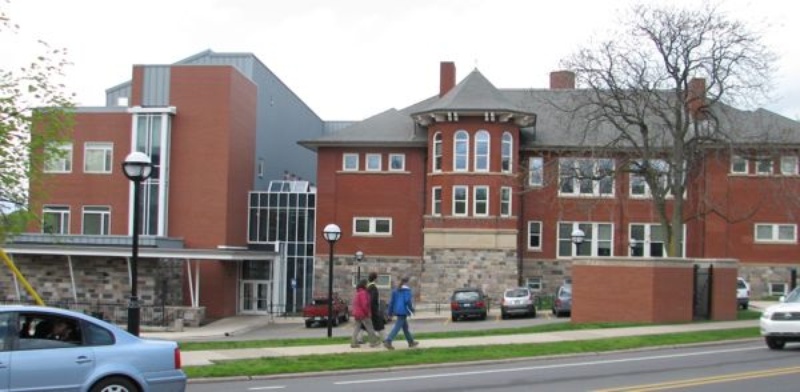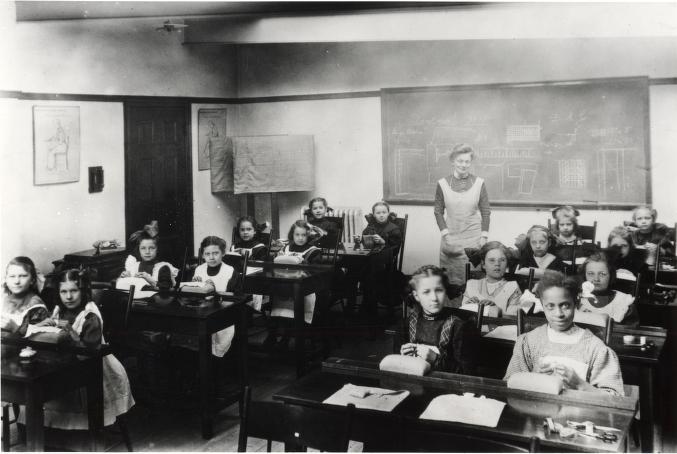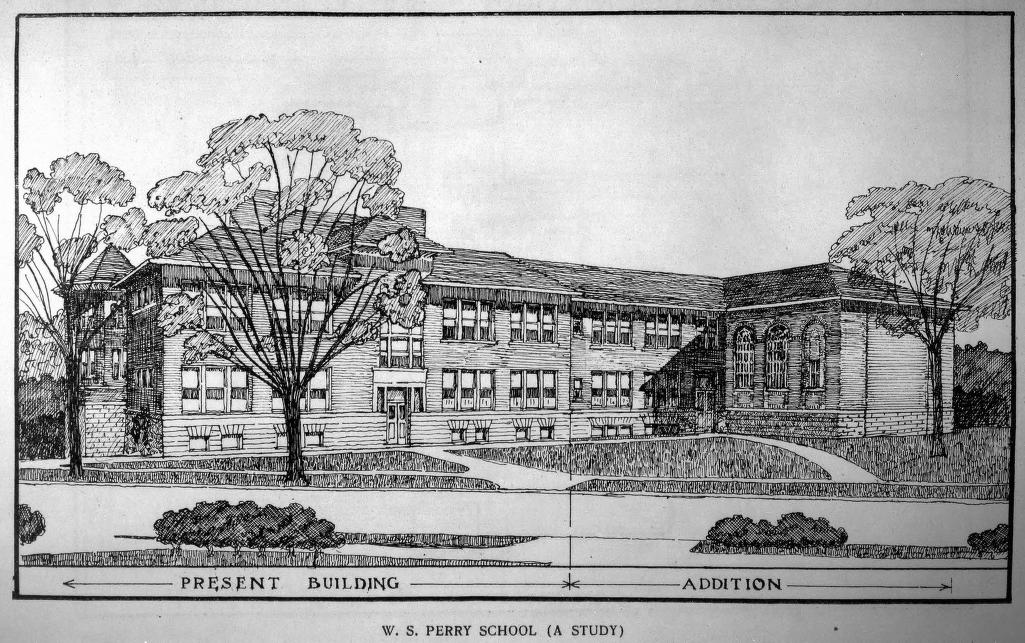Perry Building
A school with ties to FDR’s WPA project

The Perry Building today, situated on the south end of the University’s Central Campus
The Water S. Perry Building, located at 330 Packard Road on the southern edge of U-M’s Ann Arbor campus, currently houses the Inter-university Consortium for Political and Social Research (established 1962), a center that “maintains and provides access to a vast archive of social science data for research and instruction,” (“Centers”). This building is named for Walter S. Perry, a former Ann Arbor superintendent of schools ([Walter S. Perry papers]). While the University of Michigan purchased the school in 1967, part of a trend by the University to purchase local public schools in order to accomodate its growing needs, the building has a long history and acts as a touchpoint to many significant events in the twentieth century.
Before going further, it is important to acknowledge and differentiate the Walter S. Perry school from the other “Perry School” in the area. In the neighboring city of Ypsilanti, there is a school known as Lawrence Perry, named for Ypsilanti’s first African American school board member. Today the Lawrence Perry building is called Foundations Preschool of Washtenaw County (Shackman 2015)
The Perry Building was built shortly after the turn of the twentieth century, as the earliest records show enrollment in 1911 (“Sixth grade sewing class…”; “Building Code” 1929). Years later, with funding under President Roosevelt’s WPA Project, Ann Arbor provided additional funding for the Walter S. Perry Elementary School in 1934. Quickly garnering a reputation as an excellent school, this school specialized in serving one-parent families (Shackman 2015). At time went on, Perry Elementary received further funding under the Lanham Act (Shackman 2015). Established in 1940, the Lanham Act authorized “war-related government grants [and] childcare services in communities contributing to defense production,” (Cohen 2015). Under this program, the United States federal government spent close to $1 billion (adjusted for inflation) opening and updating schools in 49 states, reaching estimates of 600,000 children (Cohen 2015). With their children in school or daycare and their husbands overseas, this program was designed to encourage women to enter the workforce related to the war effort on the homefront. Additionally, this greatly helped single or widowed mothers as it provided childcare and an opportunity to support the family in a single income household. As Rhaina Cohen of The Atlantic notes, “For the first and, to date, only time in American history, parents could send their children to federally-subsidized childcare, regardless of income,” (Cohen 2015). While the program ended after the war, community activists in the area organized to keep the school in operation, recognizing that the need for the school did not cease like the war on VJ Day.

Students in a classroom at the Perry Building, 1911.
As a school specializing in serving low-income or at-risk families, many of the students were the children of single women who were either divorced or widowed. In this era, many women had unplanned pregnancies due to the absence of the availability of safe birth control pills (Shackman 2015). As a result, many women dropped out of school, which significantly decreased their chances of finding a good paying job, and found themselves in quick and short marriages. In order to accomodate this needs, the school later became a nonprofit United Way Agency (Shackman 2015).
In terms of staffing, the Perry School’s proximity to the University of Michigan offered a convenient location for University students studying education, psychology and nursing to gain work experience (Shackman 2015).
After a number of years, the costs to maintain the school became too high for the United Way to continue to subsidize and the school was put up for sale (Shackman 2015). At the time, the University sought a space specially desiganted for its fledging Inter-university Consortium for Political and Social Research (ICPSR). Founded in 1962, the ICPSR is a center dedicated to conducting research and cultivating research methods (“Centers”). In 1967, the University bought the Perry building (Shackman 2015).
As a result of the sale of the building, faculty and students of Walter S. Perry School moved operations to a location on the outer reaches of Ann Arbor. In the long run, community members state that the new location had a positive impact on the school as it could expand its reach to families outside the Ann Arbor border (Shackman 2015).

A sketch of the W.S. Perry School, 1922
Sources
- Ann Arbor Board of Education. Catalogue of the Ann Arbor High School for the academic year. 1895-1896.
- Building Code. [Ann Arbor, MI], 1929.
- Cohen, Rhaina. “Who Took Care of Rosie the Riveter’s Kids?” 2015. https://www.theatlantic.com/business/archive/2015/11/daycare-world-war-rosie-riveter/415650/
- “Centers.” The Institute of Social Research. University of Michigan. http://home.isr.umich.edu/about/contact-us/
- Perry, Walter Scott. [Walter S. Perry (1831-1897) Pamphlets and Reprints]. The Bentley Historical Library. University of Michigan. Call number JA 1861 P465.
- “Perry Building Renovation and Addition.” Demaria Build. http://www.demariabuild.com/projects/perry-building-phase-i-2-renovation/
- Shackman, Grace. “Which Perry? There’s good news for everyone who has ever confused the two Perry preschools.” The Ann Arbor Observer , 2015. http://annarborobserver.com/articles/which_perry__full_article.html
Image credits
- “Perry Building” Ann Arbor Local Wiki. https://localwiki.org/ann-arbor/Perry_Building
- “Sixth grade sewing class, Perry School, Feb. 1911 - Miss Holen (?) teacher; HS4914” The Bentley Historical Library. University of Michigan.http://quod.lib.umich.edu/b/bhl/x-hs4914/hs4914
- “W.S. Perry School (A Study); BL000091” The Bentley Historical Library. University of Michigan. http://quod.lib.umich.edu/b/bhl/x-bl000091/bl000091